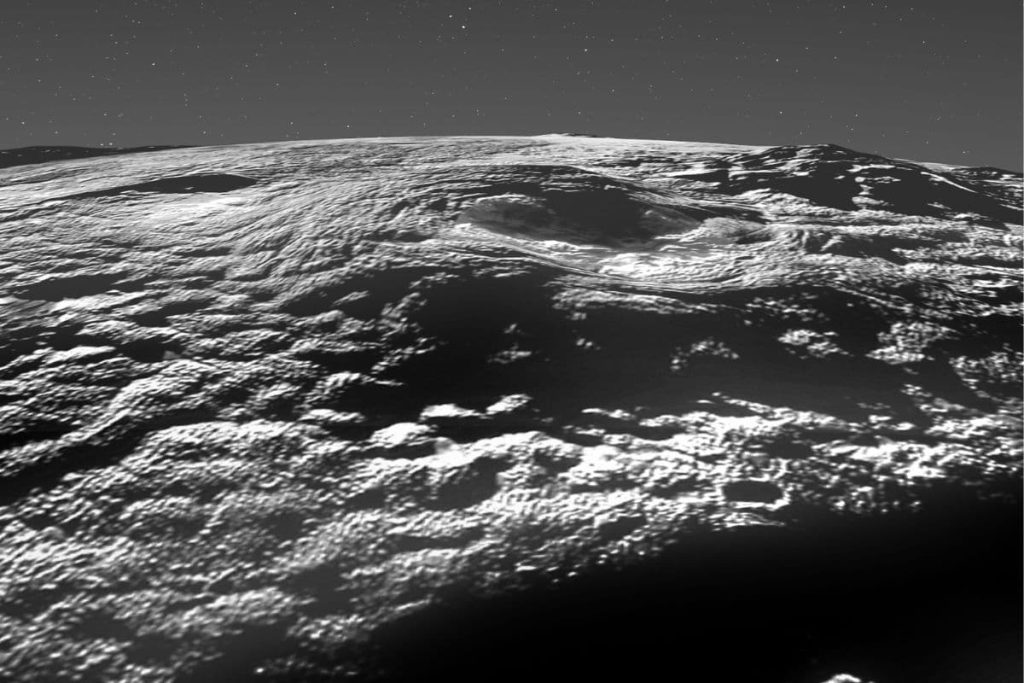And some of them must have erupted relatively recently.
It’s been about seven years since the New Horizons spacecraft passed the dwarf planet Pluto. It provided stunning views and beautiful images that revealed what the surface of this distant and mysterious world, located in the outer reaches of our solar system, looks like. The researchers are still looking at data collected by New Horizons at the time. This again leads to an exciting new discovery.
Ice volcanoes
New Horizons images of Pluto reveal a region of the dwarf planet dominated by ice volcanoes. Ice volcanoes are somewhat similar to terrestrial volcanoes, except that they do not spew molten rock, but rather a molten mixture of frozen fluids such as ammonia and water. The researchers found the area southwest of Sputnik Planitia. The well-known heart-shaped region on Pluto.

Icy volcanic field on Pluto. The surface of Pluto and its atmospheric nebulae are shown here in shades of grey. Here the technical explanation of how volcanic processes worked in the past is colored blue. Photo: NASA/Johns Hopkins University Applied Physics Laboratory/Southwest Research Institute
The researchers examined the geomorphology and composition of the area and found that the material consisted mainly of water ice. In addition, they discovered many volcanoes in the area, the height of which ranges from a few kilometers to seven kilometers (!). A glacial volcano known as Wright Mons has been found that rivals Hawaii’s Mauna Loa in size, one of the largest volcanoes on Earth. Specimens with a width of 30 to 100 km were also monitored. In addition, some volcanoes appear to have merged into larger structures.
unique
The researchers argue that such a volcanic region, characterized by large domes and ridges, cannot be seen anywhere else in the Solar System. “The specific structures we studied are unique to Pluto so far,” said researcher Kelsey Singer. The researcher suspects that material beneath the surface of this distant icy planet has been pushed up, creating the “rugged” area. “Large amounts of material have been brought back to Pluto’s surface not through erosion or other geological processes, but possibly through ice volcanoes,” Singer said.
recent bangs
Notably, unlike some parts of Pluto’s surface, the region has little or no craters at all. According to the researchers, this indicates that the region is geologically modern. Some of the ice volcanoes discovered must have erupted relatively recently. At the same time, this means that the internal structure of Pluto is much warmer than previously thought.
unexpected
the findings Show once again how much Pluto really cares. Images acquired by the spacecraft in 2015 revealed many geological features, including mountains, valleys, plains and glaciers. These were particularly interesting, as the freezing temperatures on Pluto were expected to result in a frozen, geologically inactive world. Nothing turned out to be less true. And now, seven years after New Horizons visited Pluto, researchers are making new discoveries on that distant and still mysterious dwarf planet. “One of the advantages of exploring new places in the solar system is that we find things we didn’t expect,” says Singer. “These giant, strange-looking ice volcanoes observed by New Horizons are a wonderful example of how we are expanding our understanding of volcanic processes and geological activity in icy worlds.”
teacher
According to the researchers, the new study is a milestone. “It once again shows just how geologic Pluto is,” said New Horizons principal investigator Alan Stern. “It has been incredibly active over a long period of time. And all for a small planet. Even years later flew by These new findings show that there is more to learn about the wonders of Pluto than we can imagine.”
For now, New Horizons is still flying through the Kuiper Belt. From the belt, the probe makes unique observations. But it doesn’t stop there – if it’s up to NASA. For example, another Kuiper Belt object that New Horizons could overtake to provide us with more insight into the beautiful worlds we find at the edge of our solar system is currently being searched for.

“Coffee buff. Twitter fanatic. Tv practitioner. Social media advocate. Pop culture ninja.”











More Stories
Which can cause an increase in nitrogen.
The Central State Real Estate Agency has no additional space to accommodate Ukrainians.
The oystercatcher, the “unlucky national bird,” is increasingly breeding on rooftops.